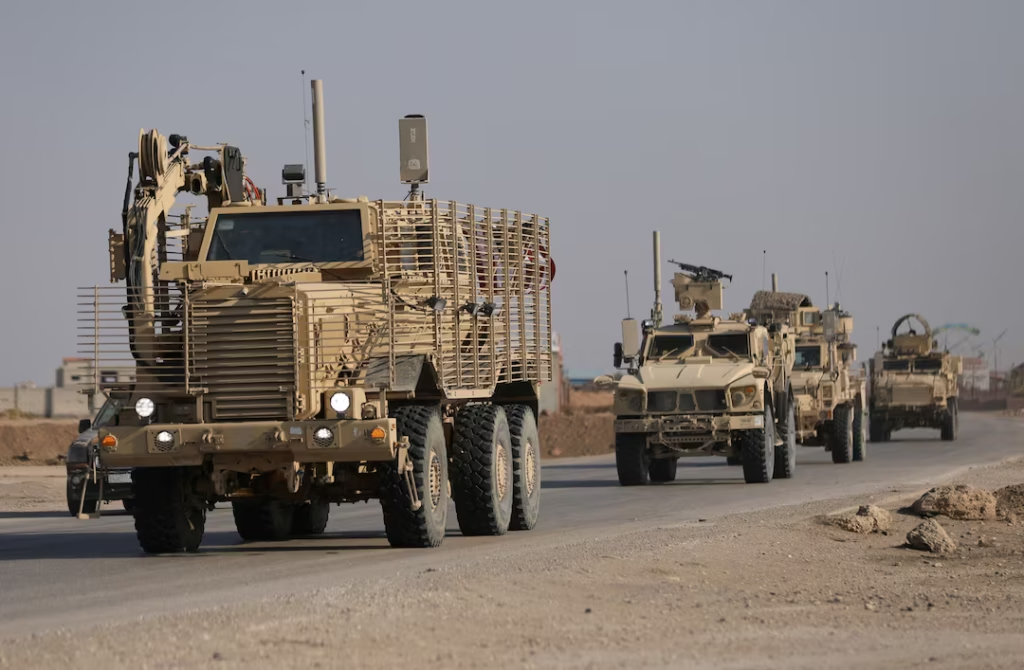HASAKA PROVINCE, Syria (BN24) — U.S. troops have quietly pulled out of two more military bases in northeastern Syria, deepening a withdrawal campaign that Syrian Kurdish leaders warn is emboldening Islamic State militants and straining an already fragile security structure.

Journalists with Reuters who visited the now-vacant Al-Wazir and Tel Baydar bases in Hasaka province last week reported finding them mostly deserted, with only small Syrian Democratic Forces (SDF) units remaining to guard the perimeters. Razor wire fences were sagging, surveillance equipment had been removed, and signs of the once-robust U.S. presence were gone.
A Kurdish official living on one of the bases confirmed that American forces had departed entirely, while SDF guards at the second base said troops had left recently but declined to specify the timeline. The Pentagon offered no comment, but these ground reports confirm the latest withdrawals, bringing the total number of vacated U.S. bases in Syria to at least four since President Donald Trump returned to office in January.
The drawdown follows a policy announcement from the Trump administration earlier this month, stating plans to reduce U.S. military outposts in Syria from eight to one, cutting troop levels from approximately 2,000 to around 500 personnel. That consolidation leaves only a single active base in territory controlled by the U.S.-backed SDF, a Kurdish-led coalition that has spent the last decade fighting Islamic State insurgents alongside the United States.
Though the SDF has not disclosed the current number of American troops or operational U.S. bases, its commander, Mazloum Abdi, voiced grave concerns in an interview with Reuters at the Al Shadadi base — now the final American foothold in the region.
“The threat of Islamic State has significantly increased recently,” Abdi said. “But this is the U.S. military’s plan. We’ve known about it for a long time … and we’re working with them to make sure there are no gaps and we can maintain pressure on Islamic State.”

Abdi said a few hundred troops at a single base are not sufficient to contain the growing ISIS threat, which has resurged in recent months — especially following the fall of Syrian President Bashar al-Assad late last year to a coalition of Islamist rebel factions.
Abdi’s remarks came just hours before the Al Shadadi base was targeted by three Iranian-made missiles, which were successfully intercepted by U.S. defense systems, according to two SDF sources. The missile attack followed Israel’s launch of an aerial assault on Iran, though Abdi declined to speculate on the regional impact of the escalating conflict.
The Islamic State, also known as ISIS or Daesh, has taken advantage of U.S. military retrenchment and political instability to ramp up its operations. The extremist group once controlled vast territories in Iraq and Syria between 2014 and 2017, enforcing a brutal Islamist rule marked by public executions, sexual slavery, and global terror attacks. A U.S.-led coalition of more than 80 countries eventually broke ISIS’s territorial grip through a protracted air and ground campaign.
However, Abdi revealed that ISIS sleeper cells are again active in multiple Syrian cities, including Damascus, and that foreign jihadist fighters have recently joined its ranks following the collapse of Assad’s regime. He noted that ISIS had looted arms and ammunition from Syrian government depots left unsecured amid the post-Assad chaos.
Several Kurdish officials told Reuters that ISIS fighters have begun maneuvering openly near recently abandoned U.S. outposts in Raqqa and Deir Ezzor — two cities once at the heart of the group’s self-declared caliphate. In territories under SDF control east of the Euphrates River, ISIS has launched a wave of ambushes, bombings, and targeted killings, Abdi said, including a roadside bomb attack on a convoy of oil tankers near Al Shadadi.
The SDF has reported at least 10 of its fighters and security personnel killed in recent attacks linked to ISIS, with militants exploiting security vacuums left by the departing American forces.
As the U.S. shrinks its military footprint in Syria, Kurdish leaders are grappling with the dual pressures of defending their territory against ISIS and preparing for new uncertainties stemming from regional tensions, including the evolving Israel-Iran conflict.
While the Trump administration insists that the drawdown is part of a long-term recalibration of U.S. military engagement in the Middle East, critics warn that the timing could undermine gains made against ISIS and destabilize Kurdish security forces who now face the insurgent threat with dwindling international support.
With only one U.S. base remaining in northeastern Syria and ISIS appearing to reorganize amid the retreat, the question confronting Washington’s Kurdish allies is whether they can hold the line without American boots on the ground. As Abdi put it, “We’re doing everything we can, but we’re watching a dangerous pattern emerge.”



